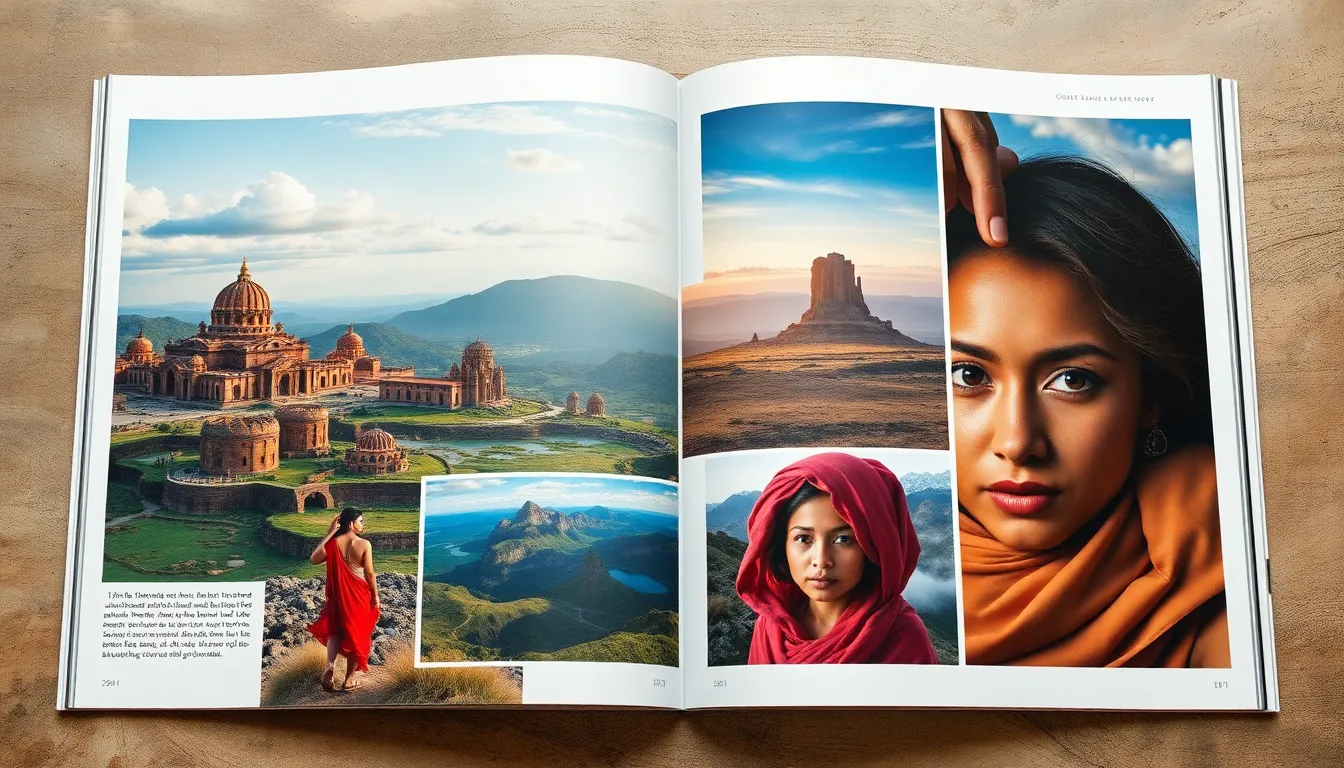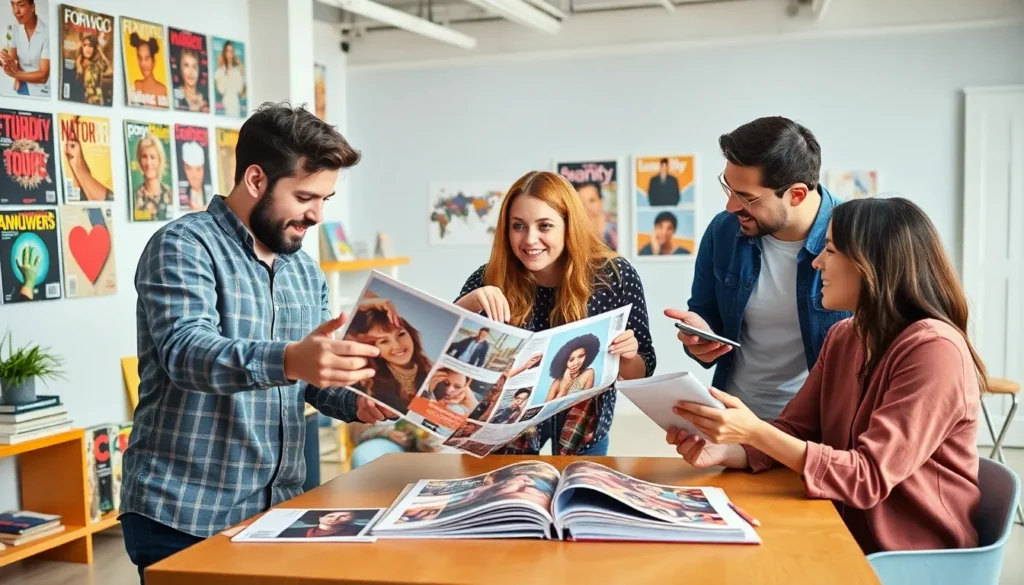Table of Contents
ToggleIn an age where attention spans are fleeting, magazines are transforming the way they communicate through visual storytelling. This powerful technique blends striking imagery with compelling narratives, captivating readers and creating an immersive experience. With each page turn, visuals not only enhance the text but also evoke emotions and spark curiosity.
Magazines harness the art of visual storytelling to convey complex ideas quickly and effectively. From bold photography to innovative layouts, these elements work together to draw readers into a narrative, making content more relatable and memorable. As the landscape of media continues to evolve, understanding the impact of visuals in magazines becomes crucial for both creators and consumers alike.
Understanding Visual Storytelling
Visual storytelling in magazines combines images and narratives to create an engaging experience. This approach captivates readers, enhances content, and makes complex ideas easy to grasp.
Definition and Importance
Visual storytelling refers to the use of images, graphics, and layouts to convey messages effectively. These elements work together to evoke emotions and facilitate understanding. Research shows that visuals increase retention by 65% compared to text alone. Engaging visuals not only attract readers but also contextualize stories, making them more relatable. In magazines, this technique enhances overall engagement and leaves a lasting impression.
Historical Context
Visual storytelling in magazines traces back to the 19th century with the advent of illustrated publications. Early magazines often featured engravings and lithographs to enhance narratives. By the 20th century, color photography revolutionized the medium, attracting a broader audience. Iconic magazines like “Life” and “National Geographic” showcased this evolution, using visuals to deepen storytelling impact. As technology advanced, the integration of graphics and infographics became prominent, shaping modern visual storytelling strategies in magazines today.
Elements of Visual Storytelling in Magazines

Visual storytelling in magazines combines various elements that enhance communication and engage readers effectively. These elements work together to create a rich narrative that resonates well beyond the text.
Imagery and Photography
Imagery and photography serve as the core components of visual storytelling. High-quality images capture attention and evoke emotions, making complex ideas more understandable. For example, a powerful portrait can convey a subject’s emotions and experiences, while striking landscapes can set the tone for a feature article. Magazines like “National Geographic” utilize stunning visuals to transport readers to different cultures and environments, demonstrating the potential of photography to create an immersive experience. According to studies, images can enhance memory retention by up to 65% compared to text alone.
Layout and Design
Layout and design play a crucial role in guiding readers through the content. Effective layouts balance text and visuals strategically, drawing the reader’s eye and creating a harmonious flow. Grid systems, white space, and visual hierarchy significantly impact usability and comprehension. For instance, the dynamic use of space in magazines like “Vogue” enables the integration of fashion photography and editorial content, allowing readers to navigate easily while enjoying a visually stimulating experience. Magazines often employ consistent design elements to reinforce brand identity and improve reader recall.
Typography and Text
Typography and text contribute to the overall aesthetic and clarity of magazine storytelling. Font choice, size, and spacing influence readability and engagement. Bold headlines and elegant serif fonts can evoke specific moods and draw in readers. For example, using a modern sans-serif font for lifestyle magazines creates a clean, contemporary look, while classic serifs might be used in literary publications for a traditional feel. Moreover, the integration of pull quotes and text highlights can emphasize key ideas, enhancing the narrative without overwhelming the reader. Effective typography ensures that the text supports visual elements, ultimately enriching the storytelling experience.
Techniques for Effective Visual Storytelling
Visual storytelling relies on various techniques that enhance reader engagement and understanding. Specific methods, like the use of color, composition, and data visualization, play a crucial role in crafting compelling narratives.
Use of Color and Composition
Color and composition establish mood and guide reader focus. Specific color palettes evoke emotions—warm tones suggest vibrancy, while cooler shades invoke calmness. Strategic use of composition balances elements, creating visual harmony. For example, the rule of thirds can direct attention to focal points, ensuring essential content stands out. In magazines like “Vogue,” color and composition combine to create visually striking layouts that resonate with the audience, enhancing their connection to the story.
Incorporating Infographics and Data Visualization
Infographics and data visualization present complex information clearly and effectively. Combining graphics with concise text transforms statistics into engaging visuals, increasing comprehension and retention. For example, a magazine article about climate change could utilize charts to display temperature trends, making the information instantly accessible. This approach captures attention and improves recall, reinforcing the magazine’s authority on the topic. Successful brands like “Wired” exemplify this technique by integrating infographics that simplify technical subjects for readers.
Storyboarding and Planning
Storyboarding and planning streamline the visual storytelling process. Conceptualizing layouts before design facilitates a coherent narrative flow, ensuring images and text complement each other. This preparation enables creators to visualize the overall structure, making necessary adjustments efficiently. For example, a planned storyboard can help determine where key visuals should appear to enhance emotional impact. Many successful magazines adopt this approach, resulting in cohesive and engaging storytelling that guides readers through the content seamlessly.
Case Studies of Successful Visual Storytelling
Various magazines illustrate successful visual storytelling through innovative approaches that captivate audiences. These case studies showcase how effective combinations of imagery, design, and narrative significantly enhance reader engagement.
Notable Magazines and Their Approaches
- National Geographic: Renowned for stunning photography that immerses readers in different cultures and environments. Each issue integrates breathtaking images and compelling narratives to create a vivid exploration of topics like nature and science.
- Vogue: Utilizes fashion photography to convey not just style but also cultural commentary. The magazine employs striking layouts and bold typography that complement the visual aesthetics, captivating its audience and evoking emotion.
- Wired: Focuses on technology and modern culture, often incorporating infographics to simplify complex data. The integration of graphics enhances understanding and allows readers to grasp intricate subjects quickly.
- The New Yorker: Combines illustrations and photography with sharp, engaging writing. The interplay between the visual elements and the narrative invites readers into a realm of commentary on current events and culture.
Analyzing Reader Engagement and Impact
Research indicates visuals can increase reader retention by as much as 65%. Successful magazines leverage this power to enhance engagement through various strategies:
- Image Selection: High-quality images draw immediate attention and elicit emotional responses. Eye-catching visuals in magazines can significantly impact initial reader engagement.
- Layout and Design Techniques: Strategic arrangement of text and visuals facilitates reading flow and encourages deeper exploration of content. Effective layouts guide users through narratives seamlessly.
- Data Presentation: Infographics serve to clarify complex information, making it digestible for readers. Publications like Wired exemplify how well-placed infographics can transform dense statistics into engaging stories.
- Brand Identity: Cohesive visual storytelling reinforces a magazine’s brand, creating a recognizable style that resonates with its target audience. Strong visual identities foster loyalty and encourage repeat readership.
In analyzing these case studies, the connection between visuals and reader engagement becomes evident, highlighting the critical role of effective visual storytelling in magazine publishing.
Challenges and Future Trends
Visual storytelling in magazines faces several challenges as it adapts to an ever-evolving media landscape. Understanding these obstacles alongside emerging trends offers valuable insights for industry professionals.
Overcoming Common Pitfalls
Visual storytelling often encounters common pitfalls that can undermine its effectiveness.
- Ignoring Audience Preferences: Tailoring visuals to fit specific audience interests enhances engagement. Failing to understand demographics may result in mismatched content.
- Overcomplicating Designs: Simple, clean layouts promote clarity. Overly busy designs can distract readers and obscure the message.
- Neglecting Accessibility: Ensuring images and text color combinations are accessible increases inclusivity. Ignoring accessibility needs may alienate potential readers.
- Underutilizing Analytics: Utilizing data analytics helps refine visual strategies. Not leveraging analytics leads to missed opportunities for improvement.
- Disregarding the Narrative: Visuals should support the story, not overpower it. When visuals overshadow the text, they disrupt the narrative flow.
The Evolution of Visual Storytelling in the Digital Age
The digital age continues to transform visual storytelling in magazines, fostering new trends.
- Interactive Elements: Incorporating interactive graphics and multimedia features engages readers more actively. Magazines like “Wired” often use clickable infographics to enhance reader comprehension.
- Augmented Reality (AR): Utilizing AR technology brings visuals to life, creating immersive experiences. Readers can interact with content in real-time, making the storytelling more dynamic.
- User-Generated Content: Leveraging user-generated visuals fosters community engagement. Magazines that incorporate audience contributions present authentic perspectives.
- Short-Form Content: Emphasizing brief, impactful visuals caters to shorter attention spans. Platforms like Instagram shape content presentation, influencing magazine styles.
- Sustainability Focus: Highlighting eco-friendly visuals aligns with growing concerns about sustainability. Magazines can emphasize environmentally responsible storytelling to resonate with conscious consumers.
Visual storytelling has become a cornerstone of modern magazine publishing. Its ability to engage readers through powerful imagery and thoughtful design is undeniable. As magazines navigate the digital landscape they must embrace innovative techniques to capture attention and evoke emotions.
The integration of visuals not only enhances comprehension but also fosters a deeper connection with the audience. As trends evolve and new technologies emerge the importance of adapting visual storytelling strategies remains crucial. Embracing these changes will ensure that magazines continue to resonate with readers and remain relevant in an ever-changing media environment.




